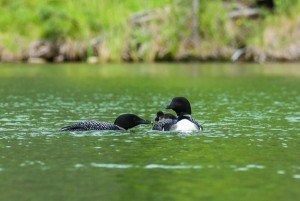With a little help from some Grade 10 students at Jasper Junior/Senior High School, the haunting calls of a loon family have once again returned to the calming shores of Lac Beauvert.

For the first time in decades the lake became the hatching place for two chicks. The first of the pair hatched June 9 while the second chick was born the following day.
“Lac Beauvert hasn’t seen any successful loon hatchings for decades,” said Ward Hughson, a Parks Canada aquatics specialist. “People would have seen individual loons on the lake, but not a family—not loon chicks.”
According to Hughson, loon families started disappearing from the lake—located near the Fairmount Jasper Park Lodge—when it began to gain popularity among hikers and tourists. Because loons are unable to walk on land they have to build their nests within a foot of shore, which can often be too close for comfort in populated areas and ends up scaring the parents into abandoning their eggs and nest.
“Loons are very secretive around their nests and they can be highly stressed out because their whole lives are invested in these eggs,” Hughson said adding that loons prefer to nest on little islands, but will settle for lakeshores. “So if you find out their secrets then they are going to move away.”
This wasn’t just a problem along Lac Beauvert, Hughson said back in 1993, Parks noticed a major decline in hatching loons around a second tourist hotspot, Pyramid Lake.
“Each year the loons attempted to build a nest and each year it was abandoned for the same reasons,” Hughson said. “It’s completely unintentional disturbances but there are always a lot of people and canoes around Pyramid and that’s often what scares the loons away.”
Hoping to bring the birds back, Parks spent eight years monitoring the loons. In 2001, Parks built an artificial nesting island, made from logs, netting material and natural aquatic vegetation. The nest was anchored down in the outlet bay of Pyramid Lake and surrounded by signage notifying passers-by to keep their distance.
The homemade nest was a success, hatching 26 chicks in the last 15 years.
Hughson said that last year a pair of loons had returned to Lac Beauvert for the first time in years, building a nest and laying one egg. However, the loon couple was startled and fled, abandoning the egg. With the return of this loon couple, Hughson thought perhaps the same plan used at Pyramid Lake could work for Lac Beauvert. Instead of doing the project alone he reached out to JJSHS Grade 10 students enrolled in the Palisades Centre’s environmental stewardship course.
“The more partners you have involved in ecological restoration the better your chances of long term success,” Hughson said. “And it really gives those students an opportunity to have a hands on experience in ecological restoration.”
Hughson also added that the staff of the Fairmount was extremely supportive and helpful with the project.
The Grade 10 students built the nest at the beginning of the school year and placed it along Lac Beauvert’s shore later that fall. Hughson said loons return to Jasper’s lakes each year after the ice has broken up and will immediately start trying to build a nest and laying eggs. Loons usually produce one or two eggs, which both parents take turns sitting on. The eggs normally hatch about a month after they have been laid.
Giela Cerezo was one of the students involved with building the latest artificial nesting island. She was at Lac Beauvert, June 9, when the first of the two chicks was born.
“It’s a good experience being a part of a project that led to the loons being hatched,” Cerezo said. “Living in Jasper, I think it’s great to be doing stuff to help the environment.”
According to Hughson, both chicks are healthy. They will spend the first few weeks of their lives riding on their parents’ backs in order to keep away from predators. The parents will stay with the babies for about 10 to 12 weeks or until the loons are fully independent.
While Hughson encourages people to visit local lakes and admire the loons, he said it is important to give the birds their space especially when the young chicks are around.
“We request that people stay about 20 metres away and never surround or follow them. This is the time when the parents are feeding their chicks and if they are stressed they can’t feed their chicks, which might cause them to not survive,” Hughson said. “Even if they come up to the side of your boat be silent and don’t follow them.”
Another way to tell if a loon is distressed is by their calls, said Hughson. They have four distinct calls that they use to communicate with their families and other loons; these are the tremolo, wail, yodel and hoot.
The tremolo call sounds like a wild laughter, but actually means the loon is stressed.
“If you’re near a loon and it makes that noise then you should step back,” Hughson said.
The yodel is only done by males and means the loon is trying to exert dominance while the hoot and wail are used to locate one another.
Despite the creation of these artificial nesting islands, Hughson said the loon population in JNP is healthy.
“We’re not trying to have more loons on the lake than what would naturally occur,” Hughson said. “It’s usually one pair that build one nest on the shore and that’s all we would ever try to duplicate because trying to do more could set aggressive behaviour between the loons.”
Kayla Byrne [email protected]
